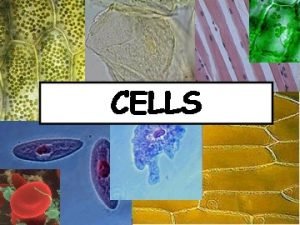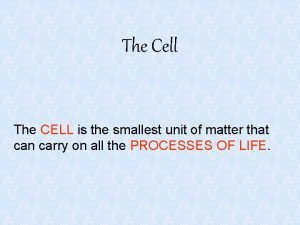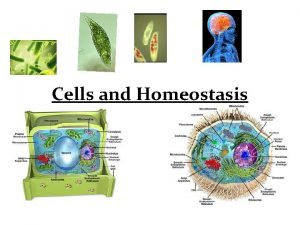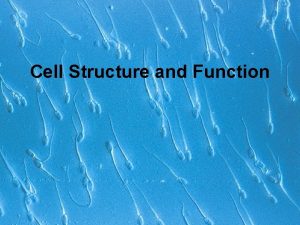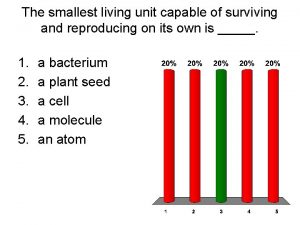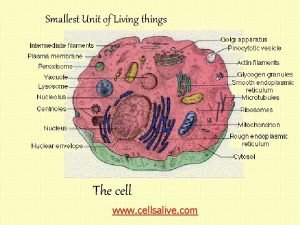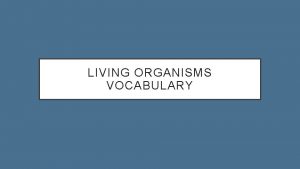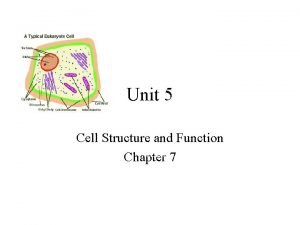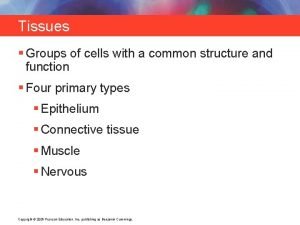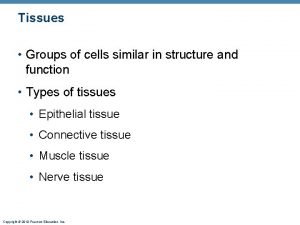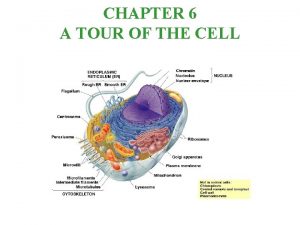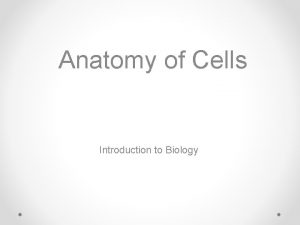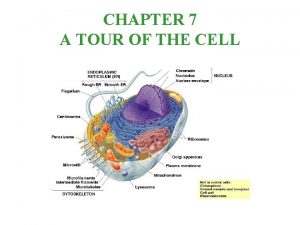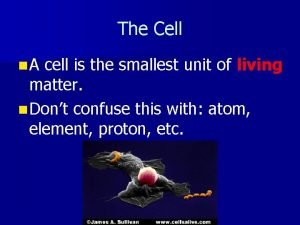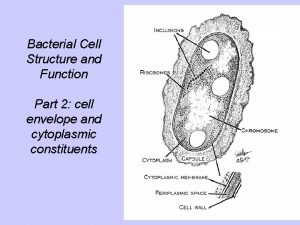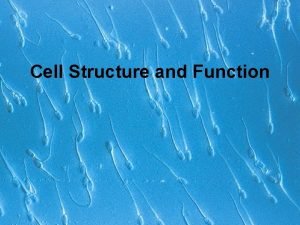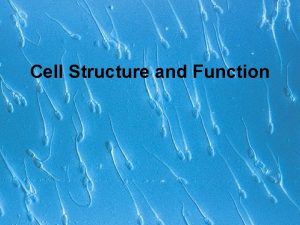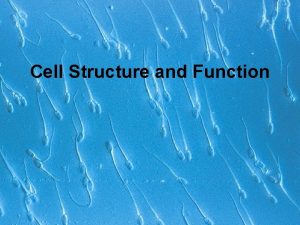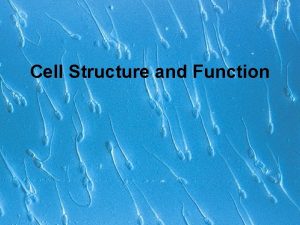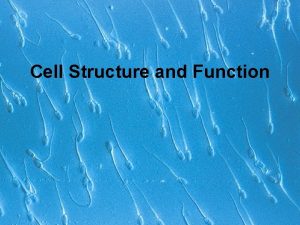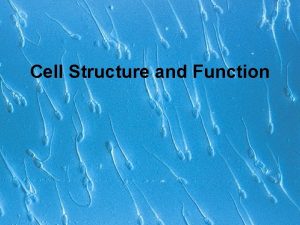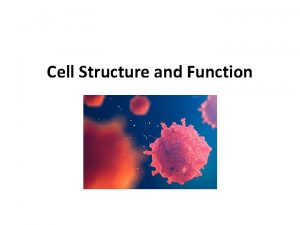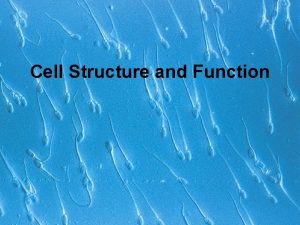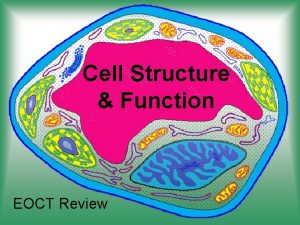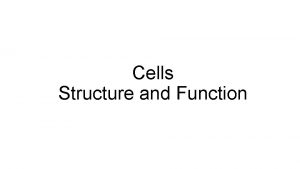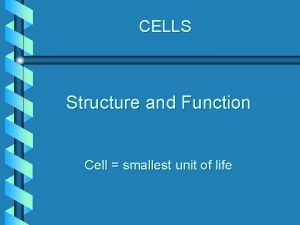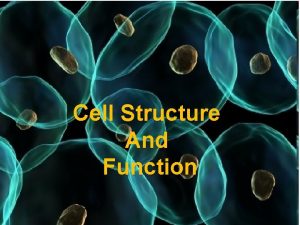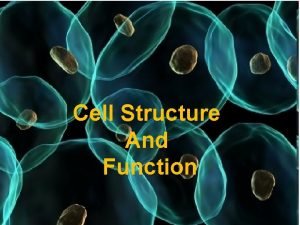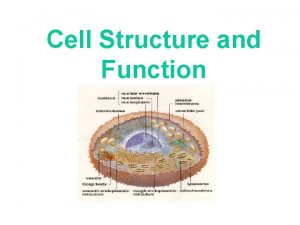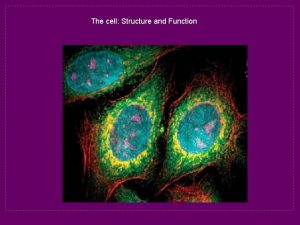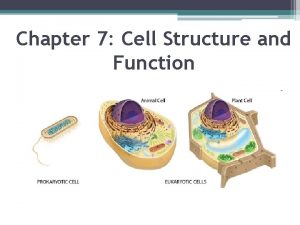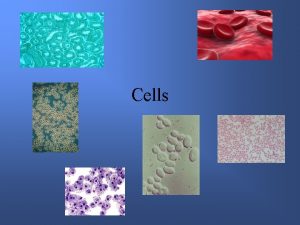Cell Structure and Function Cells Smallest living unit

























- Slides: 25

Cell Structure and Function

Cells • Smallest living unit • Most are microscopic

Principles of Cell Theory • All living things are made of cells • Smallest living unit is the cell • All cells arise from preexisting cells (this principle discarded the idea of spontaneous generation)

Cell Types • Prokaryotic • Eukaryotic

Prokaryotic Cells • First cell type on earth • Cell type of Bacteria and Archaea

Prokaryotic Cells • No membrane bound nucleus • Nucleoid = region of DNA concentration • Organelles not bound by membranes

Eukaryotic Cells • Nucleus bound by membrane • Include fungi, protists, plant, and animal cells • Possess many organelles Protozoan

Representative Animal Cell

Representative Plant Cell

Cell Membrane • Contains cell contents • Double layer of phospholipids & proteins

Cell Walls • Found in plants, fungi, & many protists • Surrounds plasma membrane

Cytoplasm • Viscous fluid containing organelles • components of cytoplasm – – Interconnected filaments & fibers Fluid = cytosol Organelles (not nucleus) storage substances

Nucleus • Control center of cell • Double membrane • Contains – Chromosomes – Nucleolus

DNA • Hereditary material • Chromosomes – DNA – Protiens – Form for cell division • Chromatin

Nucleolus • Most cells have 2 or more • Directs synthesis of RNA • Forms ribosomes

Endoplasmic Reticulum • Helps move substances within cells • Network of interconnected membranes • Two types – Rough endoplasmic reticulum – Smooth endoplasmic reticulum

Golgi Apparatus • Involved in synthesis of plant cell wall • Packaging & shipping station of cell

Golgi Apparatus Function 1. Molecules come in vesicles 2. Vesicles fuse with Golgi membrane 3. Molecules may be modified by Golgi

Golgi Apparatus Function (Continued) 4. Molecules pinched-off in separate vesicle 5. Vesicle leaves Golgi apparatus 6. Vesicles may combine with plasma membrane to secrete contents


Lysosomes • Contain digestive enzymes • Functions – Aid in cell renewal – Break down old cell parts – Digests invaders

Vacuoles • Membrane bound storage sacs • More common in plants than animals • Contents – Water – Food – wastes

Mitochondria • Break down fuel molecules (cellular respiration) – Glucose – Fatty acids • Release energy – ATP

Chloroplasts • Derived form photosynthetic bacteria • Solar energy capturing organelle

End Chapter 5
 Mitochondria information
Mitochondria information The smallest unit of life is the
The smallest unit of life is the Cells are the smallest unit of life
Cells are the smallest unit of life Cells are the smallest unit of life
Cells are the smallest unit of life Smallest living unit
Smallest living unit The smallest living unit is a
The smallest living unit is a What is the smallest living unit in the body
What is the smallest living unit in the body What is the smallest living unit
What is the smallest living unit The smallest living unit
The smallest living unit Dittulgia
Dittulgia What is the smallest unit of living organisms
What is the smallest unit of living organisms Unit 5 cell structure and function answer key
Unit 5 cell structure and function answer key Muscle tissue parts
Muscle tissue parts Groups of cells that are similar in structure and function
Groups of cells that are similar in structure and function Tissues are groups of similar cells working together to:
Tissues are groups of similar cells working together to: The cell is a living unit greater than the sum of its parts
The cell is a living unit greater than the sum of its parts Capsule flagella pili nucleoid desmosome
Capsule flagella pili nucleoid desmosome The cell is a living unit greater than the sum of its parts
The cell is a living unit greater than the sum of its parts The cell is the smallest
The cell is the smallest Development of paranasal sinuses
Development of paranasal sinuses Red blood cells and white blood cells difference
Red blood cells and white blood cells difference Plant cell and animal cell venn diagram
Plant cell and animal cell venn diagram Masses of cells form and steal nutrients from healthy cells
Masses of cells form and steal nutrients from healthy cells Function of the cell wall
Function of the cell wall Living and nonliving things venn diagram
Living and nonliving things venn diagram What is part 2
What is part 2

